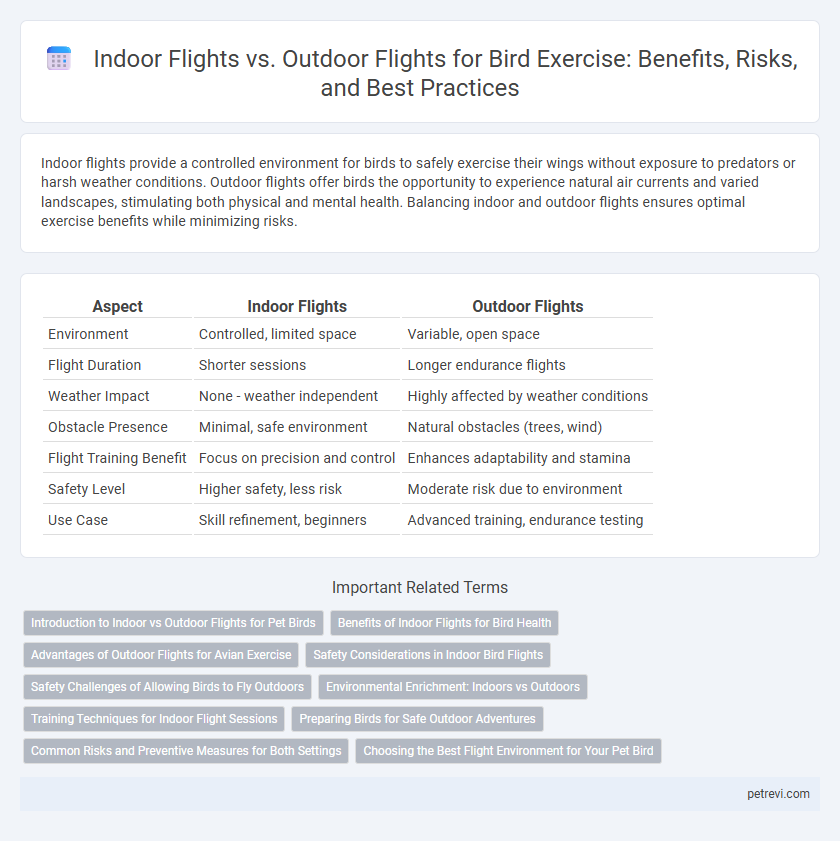Indoor flights provide a controlled environment for birds to safely exercise their wings without exposure to predators or harsh weather conditions. Outdoor flights offer birds the opportunity to experience natural air currents and varied landscapes, stimulating both physical and mental health. Balancing indoor and outdoor flights ensures optimal exercise benefits while minimizing risks.
Table of Comparison
| Aspect | Indoor Flights | Outdoor Flights |
|---|---|---|
| Environment | Controlled, limited space | Variable, open space |
| Flight Duration | Shorter sessions | Longer endurance flights |
| Weather Impact | None - weather independent | Highly affected by weather conditions |
| Obstacle Presence | Minimal, safe environment | Natural obstacles (trees, wind) |
| Flight Training Benefit | Focus on precision and control | Enhances adaptability and stamina |
| Safety Level | Higher safety, less risk | Moderate risk due to environment |
| Use Case | Skill refinement, beginners | Advanced training, endurance testing |
Introduction to Indoor vs Outdoor Flights for Pet Birds
Indoor flights provide a controlled environment that ensures pet birds' safety from predators, weather conditions, and pollutants while promoting regular exercise and mental stimulation. Outdoor flights offer natural sunlight and fresh air, which support vitamin D synthesis and improved respiratory health, though they carry risks such as escape or exposure to toxins. Balancing indoor and outdoor flight opportunities optimizes a bird's physical fitness, behavioral enrichment, and overall well-being.
Benefits of Indoor Flights for Bird Health
Indoor flights provide a controlled environment that reduces exposure to predators, harsh weather conditions, and airborne pollutants, promoting safer and healthier exercise for birds. Regular indoor flight sessions help improve muscle strength and cardiovascular health while minimizing risks of injury or illness. Additionally, indoor flights allow owners to closely monitor their bird's behavior and physical condition, facilitating early detection of health issues.
Advantages of Outdoor Flights for Avian Exercise
Outdoor flights provide birds with a diverse and stimulating environment that enhances physical fitness and mental well-being through natural wind resistance and varied terrain. Exposure to natural sunlight boosts vitamin D synthesis, which is essential for strong bones and healthy feathers. The vast open space allows for extended flight distances, promoting cardiovascular health and muscle development more effectively than indoor flights.
Safety Considerations in Indoor Bird Flights
Indoor bird flights offer a controlled environment that minimizes exposure to predators, adverse weather, and airborne pollutants, significantly reducing safety risks. Limited space indoors requires careful supervision to prevent collisions with walls, windows, or household objects, emphasizing the importance of bird-proofing the flight area. Proper ventilation and removal of toxic plants or fumes enhance air quality, ensuring a safer flight experience for birds during indoor exercise sessions.
Safety Challenges of Allowing Birds to Fly Outdoors
Outdoor flights expose birds to risks such as predation, environmental hazards, and unpredictable weather conditions that can compromise their safety and well-being. Indoor flights provide a controlled environment, reducing dangers like collisions, toxic exposure, and loss, yet may limit natural exercise stimulation and flight space. Ensuring safe outdoor exercise requires careful supervision, training, and secure aviaries to mitigate threats while promoting physical health.
Environmental Enrichment: Indoors vs Outdoors
Environmental enrichment for birds varies significantly between indoor and outdoor flights, with outdoor environments providing a naturally stimulating array of sights, sounds, and air quality that promote mental and physical well-being. Indoor flights can be enhanced with artificial plants, mirrors, and varied perching options to simulate natural habitats, though they often lack the dynamic sensory input found outdoors. Controlled indoor settings reduce exposure to predators and harsh weather, contributing to a safer yet less varied enrichment experience for avian exercise.
Training Techniques for Indoor Flight Sessions
Indoor flight training for birds emphasizes controlled environments where airflow and lighting can be adjusted to mimic natural conditions. Techniques include using flight tunnels, obstacle courses, and target perches to enhance precision, agility, and muscle strength. Consistent repetition and gradual increase in flight duration improve cardiovascular health and coordination without the unpredictability of outdoor weather elements.
Preparing Birds for Safe Outdoor Adventures
Indoor flights provide a controlled environment to build a bird's strength, coordination, and confidence, minimizing risks associated with weather, predators, and disorientation. Training sessions should gradually increase in duration and complexity to ensure the bird acclimates to different stimuli and commands. Proper harness use and pre-flight checks are essential to prepare birds for safe and successful outdoor adventures.
Common Risks and Preventive Measures for Both Settings
Indoor flights for bird exercise present risks such as collisions with windows and limited air circulation, while outdoor flights expose birds to predators, weather fluctuations, and environmental pollutants. Preventive measures include using bird-safe window markers indoors and providing supervised outdoor flight sessions with secure enclosures or harnesses to minimize escape and injury risks. Maintaining a controlled environment with proper ventilation and monitoring weather conditions also helps reduce health hazards in both settings.
Choosing the Best Flight Environment for Your Pet Bird
Selecting the best flight environment for a pet bird depends on species, safety, and environmental control; indoor flights offer controlled temperatures and reduced predator risks, making them ideal for smaller or more delicate birds. Outdoor flights provide natural sunlight and space for extended exercise, which benefits physical health and mental stimulation but require secure, enclosed areas to prevent escape and exposure to hazards. Balancing these factors ensures optimal exercise, enhancing feather condition and overall well-being.
Indoor flights vs Outdoor flights for Bird exercise Infographic

 petrevi.com
petrevi.com